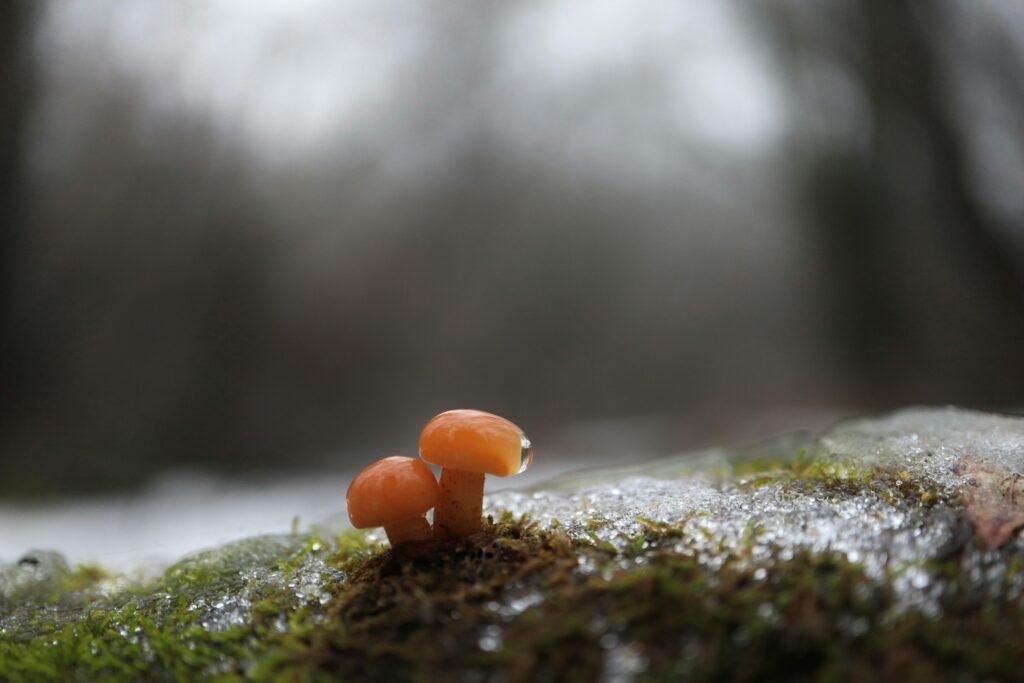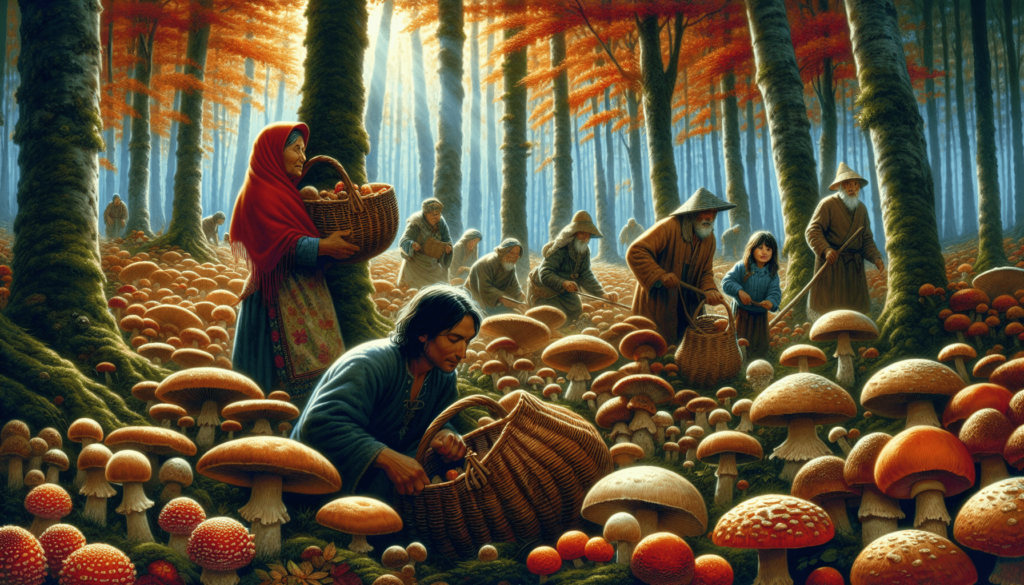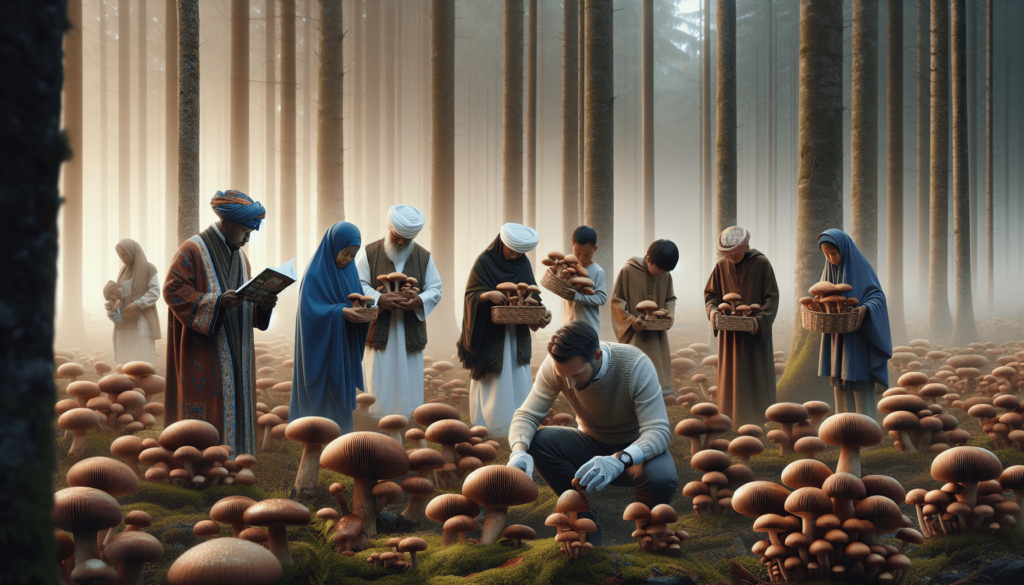Imagine wandering through a damp forest, the earthy scent of fallen leaves filling your nostrils, as you delicately pluck mushrooms from the ground. As you gather your bountiful harvest, you may find yourself wondering, what is the word for mushroom gathering? This article will explore the intriguing word that encompasses the act of foraging for these delectable fungi, shedding light on a fascinating aspect of our natural world. So, put on your hiking boots and get ready to uncover the enchanting term behind this captivating pastime.
Definition of Mushroom Gathering
Explanation of Mushroom Gathering
Mushroom gathering, also known as mushroom foraging or mushroom hunting, is the activity of searching for and collecting wild mushrooms for various purposes. It involves exploring forests, fields, and other natural habitats to find and identify different species of mushrooms. Mushroom gathering can be both a recreational activity and a means of procuring ingredients for culinary, medicinal, or scientific purposes.
Activities Involved in Mushroom Gathering
Mushroom gathering encompasses a range of activities. Firstly, it requires knowledge of mushroom identification to distinguish edible and non-edible species. This involves studying the physical characteristics, such as color, shape, and texture, as well as understanding the habitat preferences and growth patterns of different mushrooms. Once a mushroom has been identified as safe for consumption, it can be carefully harvested using a knife or scissors to avoid damaging the surrounding environment.
Another important activity in mushroom gathering is navigating the natural landscape. This often involves traversing wooded areas, hiking trails, and sometimes even climbing hills or scaling mountains to reach the desired mushroom habitats. Additionally, gathering mushrooms may require careful observation and attention to detail, as certain species may be concealed beneath fallen leaves, moss, or other vegetation.
Significance of Mushroom Gathering
Mushroom gathering holds significant value in various aspects of life. For many, it is a rewarding and enjoyable recreational pursuit that allows individuals to connect with nature and experience the thrill of discovery. Mushroom gathering also serves as a means of procuring fresh, organic ingredients for consumption, enhancing culinary experiences with unique and flavorful mushrooms. Additionally, it plays a vital role in traditional practices, ethnobotanical studies, scientific research, and cultural expressions, making it an important part of our heritage and biodiversity conservation efforts.
Mushroom Terminology
Different Words for Mushroom Gathering in Various Languages
Across different languages and cultures, the activity of mushroom gathering is known by various terms. In Spanish, it is often referred to as “recolección de setas,” while in French, it is known as “cueillette de champignons.” Similarly, in Italian, it is called “raccolta di funghi,” and in German, it is known as “Pilze sammeln.” These linguistic variations highlight the global appeal and widespread practice of mushroom gathering.
Word Origins and Etymology of Mushroom Gathering Terms
The etymology of the terms used to describe mushroom gathering reveals intriguing insights into cultural history and linguistic development. For instance, the English word “foraging” originates from the Latin word “foris,” meaning “outside,” and “foras,” meaning “outdoors.” This etymology emphasizes the connection between mushroom gathering and the act of venturing into the natural world. Similarly, the Spanish term “recolección” derives from the Latin word “recollegere,” which means “to gather.” These linguistic roots showcase the fundamental nature of gathering mushrooms from their natural habitats.

Popular Terms for Mushroom Gathering
English and Common Terms
In English-speaking countries, mushroom gathering is commonly referred to as mushroom foraging or mushroom hunting. These terms portray the adventurous and exploratory aspects of the activity. Other frequently used terms include mushroom picking, mushroom collecting, or simply mushroom hunting. These familiar terms highlight the recreational and culinary significance of gathering wild mushrooms.
Regional Terms for Mushroom Gathering
Regionally, specific terms may be used to describe mushroom gathering. In parts of the United States, Canada, and Australia, the activity is often known as mushrooming. In Nordic countries, mushroom gathering is referred to as svampskog, underscoring the traditional importance of mushrooms in Scandinavian cuisine. In Eastern Europe, it is called grzybobranie, and in Russia, it is known as gribnoi sbor. These regional terms reflect the cultural diversity and regional nuances in the practice of mushroom gathering.
Cultural References in Mushroom Gathering Terminology
The terminology associated with mushroom gathering often reflects cultural references and social significance. For example, the Italian term “funghi porcini” specifically denotes the highly prized Porcini mushrooms, which hold a special place in Italian cuisine and culture. Similarly, in Japanese, the term “matsutake” refers to a specific species of mushroom that holds great cultural importance and is often celebrated in festivals and culinary traditions. These cultural references in mushroom gathering terminology demonstrate the deep-rooted connections between mushrooms and various societies.
Traditional Practices of Mushroom Gathering
Historical Background of Mushroom Gathering
The practice of mushroom gathering dates back centuries and has been an integral part of human history. Early civilizations relied on mushrooms as a source of nutrition and medicine, utilizing their unique properties for sustenance and healing. The ancient Egyptians, Greeks, and Romans all documented their use of mushrooms for culinary and medicinal purposes. Traditional cultures worldwide, such as the indigenous peoples of North America, the Maori of New Zealand, and the Sami of Scandinavia, have incorporated mushroom gathering into their cultural practices for generations.
Traditional Techniques and Skills
Mushroom gathering requires not only experience but also knowledge of specific techniques and skills. Traditional techniques, passed down through generations, are often centered around careful observation and the interpretation of environmental cues. Certain mushrooms, for instance, are known to grow near specific tree species or at particular elevations. By acquiring these skills, mushroom gatherers can enhance their ability to locate desired species.
Moreover, traditional practices often emphasize sustainable harvesting methods to preserve the mushroom population and maintain the health of the ecosystem. Techniques such as selective harvesting, leaving behind mature specimens, and minimizing habitat disturbance are all components of responsible mushroom gathering.
Seasons and Locations for Mushroom Gathering
Mushroom gathering is often seasonal, with specific times of the year offering optimal conditions for mushroom growth. Autumn is typically the peak season for mushroom gathering, as the cool and moist environment is favorable for many species. However, depending on the geographic location, certain mushrooms may also be found during spring or summer. The availability of mushrooms can vary depending on climate, weather patterns, and local biodiversity.
Different mushroom species have specific preferences for habitat and can be found in various locations, such as forests, grasslands, or even decaying logs. Pine forests, for example, are known to harbor sought-after mushrooms such as the beloved Porcini. Understanding these seasonal and locational patterns is crucial for successful mushroom gathering.
Sustainable Practices and Conservation
In recent years, there has been growing awareness about the importance of sustainable practices in mushroom gathering. Increased demand and over-harvesting can lead to the depletion of mushroom populations and harm delicate ecosystems. As a result, responsible mushroom gathering has become an important aspect of conservation efforts.
Adhering to sustainable practices involves respecting the environment, only harvesting when necessary, and leaving behind enough mushrooms for natural regeneration. Additionally, promoting education and awareness about the ecological and cultural significance of mushrooms plays a crucial role in fostering sustainable mushroom gathering practices.

Modern Trends in Mushroom Gathering
Increased Interest in Mushroom Foraging
In recent times, there has been a surge of interest in mushroom foraging, driven by a growing appreciation for sustainable, locally-sourced food and the desire to reconnect with nature. More people are embracing mushroom gathering as a recreational activity, a way to unwind from the stresses of daily life and explore the wonders of the natural world. The diversity and abundance of mushrooms make it an intriguing and accessible hobby for individuals of all ages and backgrounds.
Mushroom Hunting as a Recreational Activity
Mushroom hunting has become a popular recreational pursuit, drawing enthusiasts to nature’s bountiful landscapes. It offers a unique blend of adventure, treasure hunting, and scientific exploration. Many mushroom hunters enjoy the challenge of identifying and collecting various species, immersing themselves in the beauty of the outdoors. The excitement of finding rare or delectable mushrooms further adds to the appeal of this engaging pastime.
Educational Programs and Courses on Mushroom Gathering
To meet the growing demand for knowledge and skills in mushroom gathering, educational programs and courses have emerged. These programs provide opportunities for individuals to learn about mushroom identification, safe harvesting practices, and the ecological importance of fungi. By equipping enthusiasts with the necessary knowledge and skills, these educational initiatives contribute to the responsible and sustainable enjoyment of mushroom gathering.
Mushroom Foraging Communities and Online Platforms
The advent of technology and social media has facilitated the formation of mushroom foraging communities and online platforms. Enthusiasts can connect with like-minded individuals, share their experiences, and exchange valuable information. Online resources, such as forums, websites, and social media groups dedicated to mushroom gathering, offer a wealth of knowledge, identification guides, and even virtual forays into the mushroom-rich landscapes of different regions.
Legal Regulations and Safety Guidelines
Permits and Legal Requirements for Mushroom Gathering
In some regions, mushroom gathering may be subject to specific regulations and legal requirements. Certain areas designate protected zones, instructing gatherers to obtain permits or licenses to prevent damage to fragile ecosystems or ensure sustainable practices. Staying informed about local regulations is essential to avoid legal issues and maintain the integrity of natural environments.
Protected Mushrooms and Species
To preserve biodiversity, certain mushroom species may be protected or declared as endangered, making their collection illegal. These regulations aim to safeguard vulnerable mushrooms from over-harvesting, ensuring their survival in the wild. Protected mushrooms often possess unique ecological roles or possess medicinal and scientific value. Mushroom gatherers must be aware of these protected species and refrain from gathering or disturbing them.
Safety Precautions and Risks in Mushroom Gathering
It is crucial to prioritize safety while engaging in mushroom gathering. Some mushrooms are toxic or potentially deadly if consumed, making proper identification essential. Beginners should consult experienced gatherers or mycologists to learn about edible and poisonous species. Additionally, mushroom hunters should be cautious of environmental risks, such as rough terrain, venomous creatures, or adverse weather conditions. Wearing appropriate clothing, using tools cautiously, and carrying emergency supplies are important safety measures.
Importance of Proper Identification and Knowledge
Accurate identification of mushrooms is of utmost importance to avoid health risks and ensure a positive mushroom foraging experience. Misidentification of poisonous or hallucinogenic species can lead to severe illness or even fatalities. Developing knowledge in mycology or consulting with experienced mushroom gatherers can help build the necessary expertise for confident identification. Reliable field guides, online resources, and participating in workshops or guided forays can also enhance identification skills.

Culinary Uses of Gathered Mushrooms
Cooking and Recipe Ideas for Wild Mushrooms
The culinary world presents endless possibilities for utilizing gathered mushrooms. From simple sautés to intricate dishes, wild mushrooms add a distinctive flavor and texture to a wide range of preparations. Sautéed wild mushrooms with garlic and herbs make a delectable side dish, while mushroom risotto showcases their earthy richness. Grilled mushrooms, mushroom soups, and mushroom-based sauces are also popular culinary applications. Exploring cookbooks, attending culinary workshops, and experimenting with different recipes can enhance the gastronomic potential of gathered mushrooms.
Popular Dishes and Traditional Cuisine
Across cultures, gathered mushrooms hold an esteemed place in traditional cuisine. Boletus edulis, commonly known as Porcini, features prominently in Italian and French cooking, with dishes like Risotto ai Funghi and Cèpe Mushroom Soup being cherished classics. In Eastern European cuisine, dishes like Mushroom Pierogi and Mushroom Soup pay homage to mushroom gathering traditions. Moreover, Asian cuisines, such as Japanese, Chinese, and Korean, incorporate unique mushroom varieties into stir-fries, soups, and hot pots, showcasing the diverse culinary heritage of mushroom gathering.
Health Benefits and Nutritional Value of Wild Mushrooms
Beyond their delicious taste and culinary versatility, gathered mushrooms also offer various health benefits. They are low in calories and fat, making them a nutritious option for those seeking a balanced diet. Mushrooms are also a good source of vitamins, minerals, and antioxidants, contributing to overall well-being. Additionally, certain medicinal mushroom varieties, like the reishi and shiitake, are believed to possess immune-boosting and anti-inflammatory properties, making them valuable ingredients in traditional medicine and herbal remedies.
Culinary Experiences and Festivals
Mushroom gathering not only provides ingredients for cooking but also offers unique culinary experiences. Mushroom festivals, celebrations, and culinary events often showcase the diversity of mushrooms, allowing attendees to savor dishes prepared by renowned chefs or community members. These events provide an opportunity to immerse oneself in mushroom culture, taste a variety of mushroom-based delicacies, and learn from culinary experts.
Mushroom Gathering as a Cultural Phenomenon
Mushrooms in Folklore and Mythology
Mushroom gathering has long held a place in folklore, mythology, and traditional beliefs. Many ancient cultures associated mushrooms with enchantment, mystical powers, and spiritual significance. In Norse mythology, mushrooms were linked to the god Odin and were believed to possess magical properties. In the Americas, indigenous tribes revered mushrooms for their connection to nature and the spiritual realm. These mythological and cultural associations reveal the deep-rooted fascination and reverence for mushrooms throughout human history.
Symbolism and Rituals Associated with Mushroom Gathering
The act of mushroom gathering often carries symbolic meaning and is associated with rituals and ceremonies in certain cultures. For example, in Slavic folklore, the gathering of wild mushrooms symbolizes good fortune and prosperity. In Siberia, the Khanty people perform rituals to ensure a successful mushroom harvest, showing their recognition of the spiritual dimension of mushroom gathering. These rituals and symbolic associations not only reflect cultural beliefs but also reinforce the importance of mushrooms in different societies.
Artistic and Cultural Expressions of Mushroom Gathering
Mushroom gathering has inspired various forms of artistic and cultural expression. Artists, writers, and photographers have depicted mushrooms in paintings, literature, and images, capturing their beauty and symbolic significance. Traditional crafts, such as mushroom carving or basket weaving, are prevalent in regions where mushroom gathering is deeply ingrained in cultural practices. Furthermore, festivals, exhibitions, and storytelling traditions centered around mushrooms provide platforms for celebrating and preserving mushroom gathering as part of cultural heritage.

Scientific Research and Studies
Ethnobotanical Studies on Mushroom Gathering
Ethnobotanical studies explore the cultural significance of mushrooms in different communities and shed light on traditional knowledge and practices associated with mushroom gathering. These studies document the diverse uses of mushrooms in cooking, medicine, rituals, and everyday life, providing valuable insights into the historical and cultural dimensions of mushroom gathering.
Ecological Impacts and Biodiversity Studies
Scientific research on mushroom gathering also focuses on the ecological impacts of the activity and its role in biodiversity conservation. Studies examine the effects of harvesting practices on mushroom populations, the relationship between mushrooms and their natural habitats, and the ecological functions of fungi in ecosystems. Research contributes to a better understanding of the balance between human enjoyment of mushroom gathering and the preservation of natural habitats.
Medicinal and Pharmacological Research
Mushrooms have long been recognized for their potential medicinal properties, leading to extensive research on their pharmacological benefits. Scientific studies investigate the therapeutic potential of various mushroom species, exploring their bioactive compounds, immune-modulating effects, and potential applications in treating diseases such as cancer, diabetes, and cardiovascular conditions. Continued research in this field may yield valuable insights into new medical treatments and pharmaceutical products.
Exploration of Mycology and Fungal Sciences
The practice of mushroom gathering fuels exploration in the field of mycology, the scientific study of fungi. Mycologists delve into the taxonomy, genetics, ecology, and physiology of mushrooms, enriching our understanding of these complex organisms. By studying mushroom gathering practices, researchers gain valuable data about species distribution, habitats, and the evolutionary relationships between different fungi. These scientific pursuits contribute to advancements in mycology and foster further appreciation for the remarkable world of fungi.
Conclusion
Summary of the Word for Mushroom Gathering
Mushroom gathering, known by various names across cultures, is the activity of searching for and collecting wild mushrooms. It involves a range of activities, from identification to harvesting, and serves as a significant aspect of our cultural, culinary, and ecological heritage.
Importance of Mushroom Gathering in Various Contexts
Mushroom gathering holds importance in several domains. It connects individuals to nature, fosters sustainable practices, offers recreational opportunities, and provides fresh ingredients for diverse culinary creations. Moreover, it has cultural, historical, and scientific significance, contributing to our understanding of mushrooms’ role in society.
Future Prospects and Challenges for Mushroom Gathering
As the interest in mushroom gathering continues to grow, it is crucial to ensure the practice remains sustainable and in harmony with ecosystems. Collaboration between mushroom gatherers, scientists, policymakers, and communities can help establish responsible practices, protect biodiversity, and conserve traditional knowledge. By promoting education, research, and cultural appreciation, mushroom gathering can thrive as a cherished activity, enriching our lives and nurturing our connection to nature.

